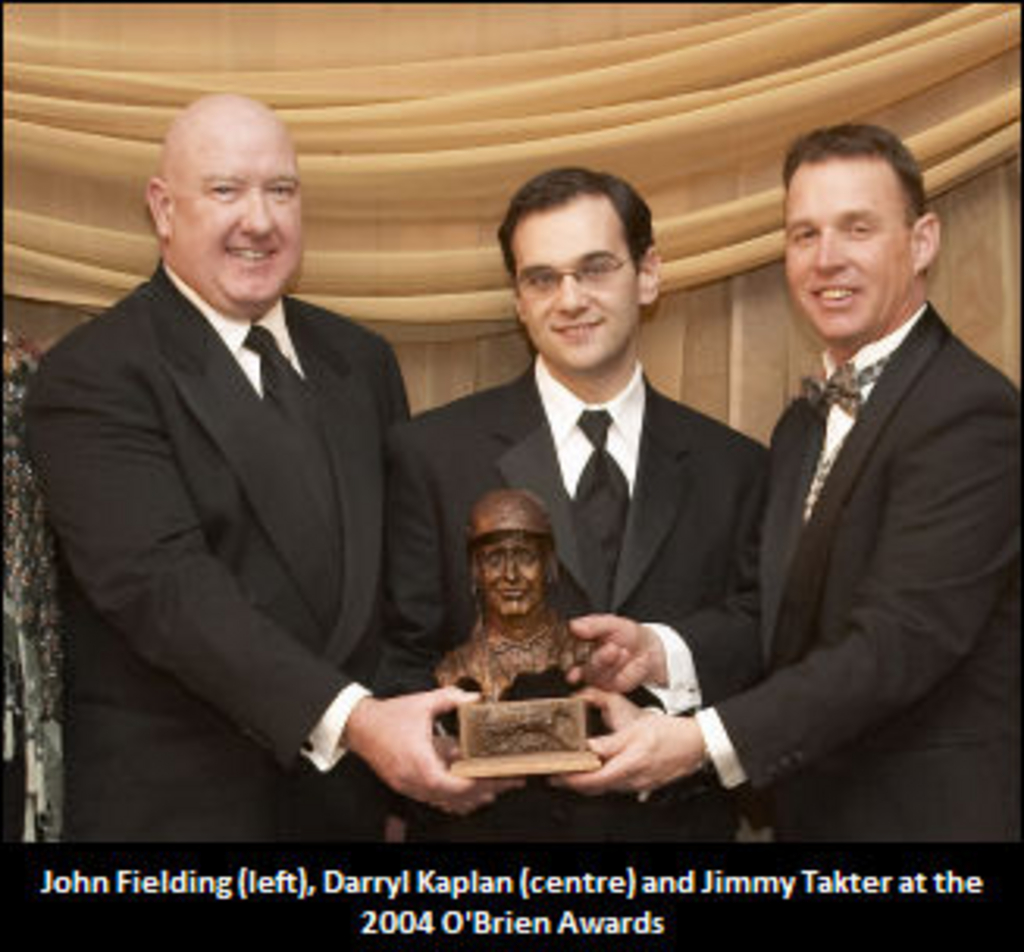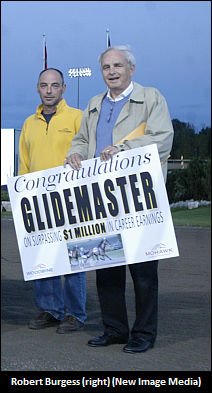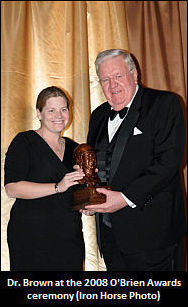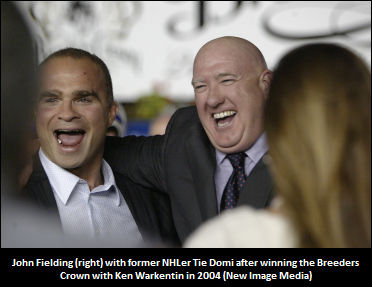
It is one of the most powerful committees in Ontario's standardbred industry. Its policies help set the tone for the Woodbine Entertainment Group's harness racing circuit, yet little is known about WEG's Standardbred
Committee. Trot Insider has spoken with incoming Standardbred Committee chairman John Fielding, former chair Dr. Glen Brown, and veteran committee member Robert Burgess about the inner workings of the committee and its state heading into 2010.
The Woodbine Entertainment Group has many advisory committees which report to the board of directors. It only seems natural that with harness racing being such a large part of the Ontario Jockey Club and WEG's business, a standardbred committee would have been a given from day one. Although, as respected breeder and WEG director Robert Burgess recently told Trot Insider, that was not always the case.
 "[Dr. Glen Brown] and I went on the [OJC board of directors] at the same time -- we had the racing stoppage in 1985 and one of the things that was done to try to resolve the impasse was to get greater standardbred representation on the board," Burgess explained. "As a result, myself, Dr. Brown and the late Max Webster were nominated to the board. At that time the board was much larger -- I believe it was increased to 22 people -- and we were added. There were a couple -- I don't want to knock anybody -- of token standardbred representatives on the board at the time, but otherwise it was a rather thoroughbred board.
"[Dr. Glen Brown] and I went on the [OJC board of directors] at the same time -- we had the racing stoppage in 1985 and one of the things that was done to try to resolve the impasse was to get greater standardbred representation on the board," Burgess explained. "As a result, myself, Dr. Brown and the late Max Webster were nominated to the board. At that time the board was much larger -- I believe it was increased to 22 people -- and we were added. There were a couple -- I don't want to knock anybody -- of token standardbred representatives on the board at the time, but otherwise it was a rather thoroughbred board.
"David (Willmot) is a very enlightened person and understands and owns on both sides of the industry. But David was not president at that time, he certainly was not in a position of any power then, so I'm not criticizing the current people at all, but at the time it was perceived that there was a very heavy thoroughbred bias in respect to the way Woodbine's affairs were run. We got down to many tricky issues later, for example, the selling of Greenwood (Raceway), the movement of the standardbreds to Woodbine, all kinds of things happened after that. But at that time there was a very bitter battle and it helped resolve the settlement to get back racing. Shortly after that, Glen was named the chairman of the standardbred committee."
"I was on the [OJC/WEG] board of directors for 24 years," Dr. Brown told Trot Insider. "During that time, the board went through all types of industry climates, both good and bad. I chaired the standardbred committee for somewhere between 15 and 20 years."
Dr. Brown has retired from the WEG board, after having celebrated his 75th birthday in July, 2008. Thus, the WEG Standardbred Committee is now helmed by John Fielding, who, according to Burgess and Dr. Brown, has a massive stake in the harness business in terms of horse ownership and also owns a successful thoroughbred breeding operation.
"There isn't anybody that I know of in the entire industry that is in on as many horses as John Fielding is," Dr. Brown told Trot Insider. "You would be very hard-pressed to, on a weekly basis, look through the programs for the majority of tracks going and not find horses that John is, or was, involved with in one way, shape or form. His investment in this industry is a great one and so is his passion for the game."
"We (Burgess' operation) would have 45 or 50 broodmares, the resulting progeny and 25 racehorses, I guess," Burgess explained, "but John Fielding would have the greatest number [of horses], I think, if you add his standardbreds and his thoroughbreds."
So what is the purpose of the standardbred committee? Why does it exist? Why is such a specialized committee needed? Fielding, Dr. Brown and Burgess explained to Trot Insider why the role of the committee is a very essential component of the corporate setup.
"This particular sub-committee is obviously the most important of the sub committees in regard to the standardbred division," Burgess said. "There are various other sub committees, but I would say that this is the only sub committee that really drives [WEG standardbred] policy.
"[WEG] is a non-profit corporation, but it operates in the same manner as a normal board would. It meets and considers what is needed, currently, and it passes a resolution in that is then relayed to the full board where it is either adopted or not," Burgess explained. "Some of the things that we [discuss] are track conditions, and a lot of other general issues. Those things do not form resolutions; those items are just dealt with from a 'housekeeping' aspect, if you will. Otherwise, if the direction of the corporation is going to be changed, we have to do something else (form resolutions)."
 "The standardbred directors are at the track, in the paddock, the backstretch and the grandstands," Dr. Brown said. "They get a pulse of what is going on in the local industry and they get a strong feel of what direction WEG should be going for the best of the industry."
"The standardbred directors are at the track, in the paddock, the backstretch and the grandstands," Dr. Brown said. "They get a pulse of what is going on in the local industry and they get a strong feel of what direction WEG should be going for the best of the industry."
"The committees are advisory committees for the board of directors," Fielding explained. "Management makes very important decisions with the blessing of the board. One of the aspects of being the chair of the standardbred committee is to be a bit of a sounding board, to a certain extent. I chair the meetings, and the committee meets quarterly. During those meetings, management will present to the standardbred committee any issues it may have or ask for suggestions, etc."
"The standardbred committee is not unwieldy -- it's quite effective," said Burgess. "We have the formal meetings every three months and there is an agenda prepared. When Dr. Brown was chair, he would call around and ask directors if there were items that they wanted on the agenda. That's how policy got started and we'd have the meeting."
Fielding understands the importance of his role as chair of the standardbred committee, and told Trot Insider that decisions which are made in the quarterly meetings can have a major impact on the Ontario harness racing landscape. "The Standardbred Committee is responsible for considering all issues in regard to standardbred racing at Woodbine and Mohawk and reporting on these issues to the WEG board of directors. The board, in turn, is responsible for ensuring that the corporation remains financially viable in order to play the critical role it currently does in today's horse racing market in Ontario and in Canada."
In addition to Fielding and Burgess, the WEG Standardbred Committee is currently comprised of David Willmot (WEG chairman and CEO), Bob Anderson (also chair of the WEG Thoroughbred Committee), Clay Horner, Doug Millard and Nick Eaves.
"We have all of the right personnel on the committee. They're all very knowledgeable and vested harness racing owners. With the management team in behind the committee, I'm very fortunate to be in a position where I am surrounded by what I consider the top minds in the industry," said Fielding, who also praised the professionalism and dedication of Steve Mitchell, Jamie Martin, Bruce Murray, Scott McKelvie and the entire staff of the WEG standardbred race office.
"I think it's always very important to have a strong leader, but it is also equally important to have a strong board behind you," said Dr. Brown, "without it, you're kind of like a leaf in the wind. The board at WEG is strong with some of the brightest and most articulate minds in the industry."
Fielding told Trot Insider that it is both a privilege and an honour to be chair of the standardbred committee, and realizes that he has some big shoes to fill.
 "Dr. Brown has the utmost in morals and is an integrity-driven individual," Fielding said. "He always did what was right for the horsemen and the sport itself. 'Doc' Brown dedicated his life to harness racing. The thing I learned the most from him is to take the moral approach and do it for the love of the game. I've been going to the harness races since I was 13 years old, and I share that love and passion for the game that he has. All I can do is continue to do what is right for the game on mass. WEG also has that responsibility to the betting public, because they are our customer."
"Dr. Brown has the utmost in morals and is an integrity-driven individual," Fielding said. "He always did what was right for the horsemen and the sport itself. 'Doc' Brown dedicated his life to harness racing. The thing I learned the most from him is to take the moral approach and do it for the love of the game. I've been going to the harness races since I was 13 years old, and I share that love and passion for the game that he has. All I can do is continue to do what is right for the game on mass. WEG also has that responsibility to the betting public, because they are our customer."
With Fielding settling into the role of standardbred committee chair, there will obviously be at least a slight change of course in terms of how Fielding opts to operate.
"John has a different corporate background and brings a completely different set of abilities," Burgess told Trot Insider. "Dr. Brown is an insider of the industry and devoted his life to the game. John has many businesses and brings some other elements to the table. To this point, John has only been a member of the committee, and John is a relatively new director of Woodbine, so at this point I'm not exactly sure in which way John is going to manage the committee."
In terms of the current state of the Canadian horse racing, it is fair to say that the industry is in a state of retraction. Thus, the industry faces challenges. How will WEG be meeting these challenges? What course of action will be taken?
"I think that we're doing relatively well at Woodbine. We're in a dreadful economy, and in my view the racing at Woodbine and Mohawk is holding its own relative to the economy," Burgess told Trot Insider. "Whether we're in a 'v-shaped' recession or something else, I don't know -- I don't know when it is going to change. So we have issues with the economy, so that may have a serious impact on the people that can buy horses. At the moment, frankly though, there is a brisk trade in racehorses and the yearling sales in Kentucky weren't that bad. But I don't think there is much that we can do in the committee to overcome a bad economy. The other thing which is holding up relatively well is the slot revenue. So far through this recession, Woodbine and Mohawk have held their own."
When posed with the same query, Fielding told Trot Insider that the company just has to keep its eye on existing goals and be able to try to apply proactive practices which can lead to future gains.
"We're in a very tough environment right now, but I think the product we are putting on is excellent and I think that is what we strive to do," said Fielding, echoing some of Burgess' sentiments. "We're continually trying to make it the best product available, and I think our product right now is a good product. There is always room for improvement, but that management team is always looking at new ways to improve the product, and they are doing everything that they can on a continual basis.
"I think the industry is contracting a little bit, and that is a worry for everybody. I think that all we (WEG) try to concentrate on is putting forth the best product that we can for our customer, the wagering public, and that includes sticking to our guns as far as integrity goes. If you put an integrity and morally-driven sport forward, the people are going to wager. You can see that with the success of this year's Queen's Plate and North America Cup."
When it comes to the future of the Ontario horse racing industry, Fielding points toward the erection of Woodbine Live!, the multi-million-dollar expansion at Woodbine Racetrack. "If and when it becomes a successful item, who knows what can happen to this game," he said. "Woodbine Live! could single-handedly be the great resurgence of the sport in Canada. The awareness of horse racing is going to be unbelievable."


I don't understand how Mr.
I don't understand how Mr. Burgess ca state that WEG is a non profit corporation. When in fact the WEG is a profit driven corporation.